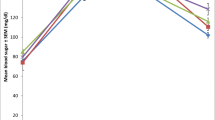Abstract
The nature of the dietary component responsible for adipocytes having the ability to respond to Glucose Tolerance Factor (GTF) was investigated. Rats were raised on either a control diet or one of three diets differing only in the protein source (torula yeast, brewer's yeast, or casein). Only in adipocytes from rats fed the torula yeast diet did a GTF fraction prepared from brewer's yeast potentiate the action of suboptimal concentrations of insulin in the incorporation of label fromd-[1-14C]-glucose andd-[U-14C]-glucose into CO2 and fatty acids. It was concluded that this potentiation was not the result of a deficiency of GTF activity in torula yeast, because a GTF fraction prepared from torula yeast had similar insulin potentiating activity. Differences in response among diets were not owing to differences in levels of amino acids or owing to concentrations of 22 (Al, As, B, Ca, Cd, Co, Cr, Cu, Fe, K, Mg, Mo, Na, Ni, P, Pb S, Se, Si, Sn, Sr, Zn) of the 23 trace elements investigated. The level of Mn, was low in all diets, but particularly low in the torula yeast diet. Mn deficiencies have previously been implicated in perturbations of glucose metabolism, so that it is possible that this deficiency may be responsible for the effects attributed to the torula yeast diet.
Similar content being viewed by others
References
J. Barret and P. O. O'Brien,Polyhedron 4, 1 (1985).
R. A. Anderson, J. H. Brantner, and M. M. Polansky,J. Agric. and Food Chem. 26, 1219 (1978).
E. W. Toepfer, W. Mertz, M. M. Polansky, E. E. Roginski, and W. R. Wolf,J. Agric. and Food Chem. 25, 162 (1977).
National Academy of Sciences USANutrient Requirements for Laboratory Animals (1978).
W. Mertz, E. E. Roginski, and H. A. Schroeder,Am. J. Physiol. 203, 53 (1965).
D. L. Baly, J. S. Schneiderman, and A. L. Garcia-Welch,J. Nutr. 120, 1075 (1990).
Author information
Authors and Affiliations
Rights and permissions
About this article
Cite this article
Shepherd, P.R., Elwood, C., Buckley, P.D. et al. Glucose tolerance factor potentiation of insulin action in adipocytes from rats raised on a torula yeast diet cannot be attributed to a deficiency of chromium or glucose tolerance factor activity in the diet. Biol Trace Elem Res 32, 109–113 (1992). https://doi.org/10.1007/BF02784594
Received:
Accepted:
Issue Date:
DOI: https://doi.org/10.1007/BF02784594




